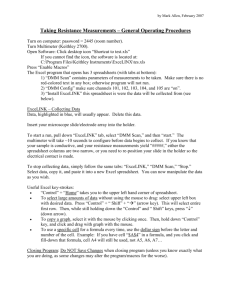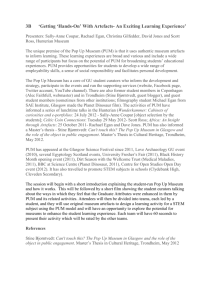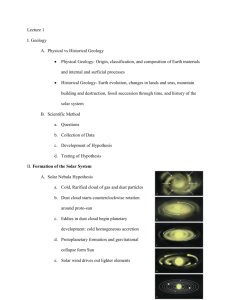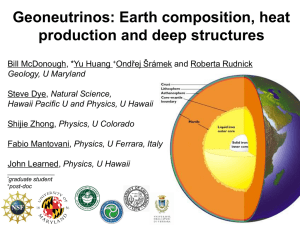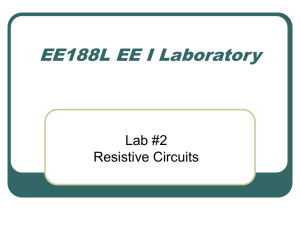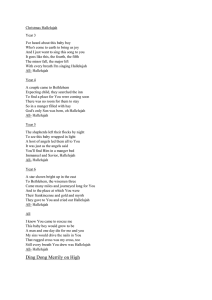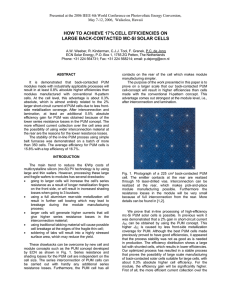Composition of the Earth
advertisement
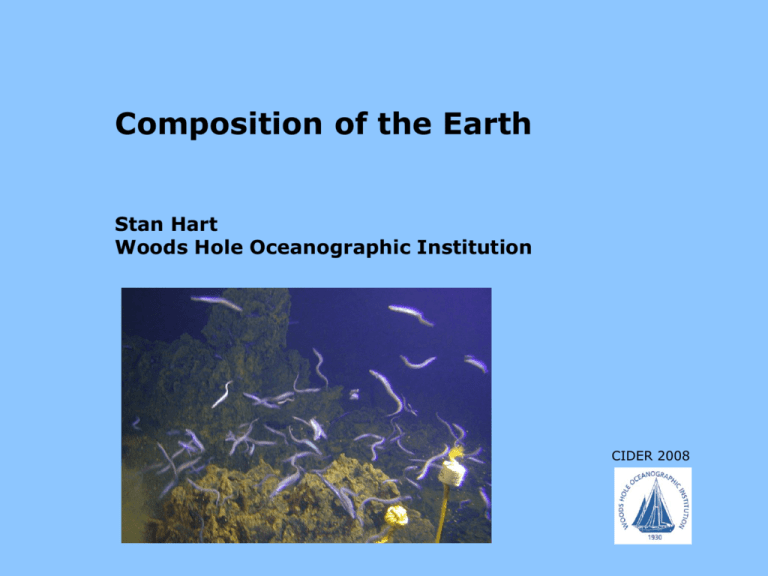
Composition of the Earth Stan Hart Woods Hole Oceanographic Institution CIDER 2008 Let’s begin at the beginning 7 4.56 Billion Years Ago ^ Courtesy of NASA/JPL-Caltech How do we determine the composition of the Earth?? Best Way: - grind up the Earth. - take a representative sample. - analyze in the lab for everything. Or we can take a desperate guess (sometimes called the chondrite model). The problem: - direct sampling to only ~15 km. - eruptive “entrainment” sampling to 200 km, and possibly to 500 km. - mantle plume advection from the base of the mantle (2900 km). If plumes exist. - no bona fide samples yet from the core. Why do we think meteorites have anything to do with the Earth? The Solar Connection: Palme and Jones 2005 Chondrites ~ Solar Nebula, to within ± 20% The Solar Connection: Allegre, Hart and Shimizu, 2008 C1 Chondrites ~ Solar Nebula, to within the uncertainties of the solar spectroscopic measurements. The Chondritic Earth model ± 1% All classes of Chondrites have the same Sm/Nd ratio (±1%!) - maybe the Earth is also the same? (note: Sm/Nd weight ratio is directly proportional to 147Sm/144Nd) The Chondritic Earth model Hutchinson, 2004 Chondrites have variable Ca/Si and Al/Si but all classes of chondrites have the same Ca/Al ratio Maybe the Earth also has the same Ca/Al? The Chondritic Earth model Condensation temperatures of the elements, °K: Al Ca Mg Fe Si - 1655° 1520° 1340° 1335° 1310° Hutchinson, 2004 Why is Ca/Si and Al/Si variable between chondrite classes? Because Si has a lower condensation temperature than Ca and Al. Then what is the Earth’s Ca/Si and Al/Si? The chondritic Earth model The first “fuzzy” step - Peridotites represent residues of partial melting. Chondrites represent differing condensation temperatures. Intersection defines the composition of the primitive upper mantle (PUM) and suggests Earth had a higher condensation temperature than chondrites. Albarede 2003 QED - we know the relative Al, Mg and Si contents of the Earth. The more the data, the fuzzier it gets! Canil 2008 Line is Canil’s best fit to the off-craton xenoliths. Blue pentagon is PUM from McDonough and Sun 1995. Al/Si Green star is PUM from Hart and Zindler 1986 (aka HaZi). (PUM = primitive upper mantle) 1.4 1.2 1.0 Mg/Si 0.8 Chondrite model can also be used for trace elements: Hart and Zindler 1986 Like Sm/Nd, Sm/Ca appears constant in chondrites (excepting some “cooked” carbonaceous chondrites). Ignore the open squares (metasomatized upper mantle peridotites). Tic marks on melting curve are % increments of melt removal. Estimated Earth Composition relative to C1 chondrites 1600°1400° 1200° 1000° 800° Refractory Element Condensation Temps Re - 1820°K W - 1790 Zr - 1740 Th - 1660 REE -1660 - 1490 (Yb) Al - 1655 U - 1610 Ti - 1580 Ca - 1520 McDonough, 2005 Semi-refractory Mg - 1340 Fe - 1335 Si - 1310 Good match for Refractory Elements (Tcond. >1500°K) Abyssal Peridotites = Simple Residues of DMM Melting Linearized relationship between two elements, A & B, in a residue of fractional melting: -1 Primitive Upper Mantle (PUM) McDonough & Sun (1995) -2 -3 -4 ln(Eu) A Co A B ln Cs Rln Cs ln C B R o -5 -6 -7 Where slope, R -8 -9 DB (1 DA ) R DA (1 DB ) -9 -8 -7 -6 -5 -4 -3 -2 -1 0 ln(Sm) Workman and Hart, 2005 Some other trace element trends in abyssal peridotites: PUM PUM We know the composition of DMM is somewhere on the regression between PUM and the least depleted abyssal peridotite - but where? Workman and Hart, 2005 We work backward from the average 143Nd/144Nd of melts from the depleted upper mantle (=0.51317). Given the Sm/Nd of PUM, we can model the evolution of a continuously depleting reservoir that ends at this present day 143Nd/144Nd of N-MORB. From this model, we can estimate the present day Sm/Nd of DMM (=0.411). The intersection of this line with the abyssal peridotite trend defines the Sm and Nd concentration of DMM. Workman and Hart, 2005 Composing Trace Element Composition of DMM Abyssal Peridotite Constraints PUM Normalized Concentrations 1.00 0.10 0.01 Rb Ba Th U Nb Ta La Ce Pb Pr Nd Sr Zr Hf Sm Eu Ti Gd Tb Dy Ho Y Er Yb Lu Workman and Hart, 2005 Composing Trace Element Composition of DMM Parent/Daughter Constraints PUM Normalized Concentrations 1.00 0.10 0.01 Rb Ba Th U Nb Ta La Ce Pb Pr Nd Sr Zr Hf Sm Eu Ti Gd Tb Dy Ho Y Er Yb Lu Workman and Hart, 2005 “Canonical” Ratios DNb > DTh Negative slope means numerator element is more compatible than denominator element. i.e mineral/melt partition coefficient Di is larger DNb ~ DU DNb < DLa Hofmann 2005 Horizontal slope means both elements have the same partition coefficient. “Canonical” ratios Some trace elements don’t fractionate from each other! So ratio in melt equals ratio in residue Spreading Center Lavas PETDB Database Composing Trace Element Composition of DMM Cannonical Ratios Constraints PUM Normalized Concentrations 1.00 0.10 0.01 Rb Ba Th U Nb Ta La Ce Pb Pr Nd Sr Zr Hf Sm Eu Ti Gd Tb Dy Ho Y Er Yb Lu Workman and Hart, 2005 Composing Trace Element Composition of DMM Connecting the Dots… PUM Normalized Concentrations 1.00 0.10 0.01 Rb Ba Th U Nb Ta La Ce Pb Pr Nd Sr Zr Hf Sm Eu Ti Gd Tb Dy Ho Y Er Yb Lu Workman and Hart, 2005 MORB Generation from model DMM Workman and Hart, 2005 Crust-Mantle Mass Balance - I How much DMM does it take to balance JUST Continental Crust? PUM normalized concentrations 100.00 CC mass = 0.6% of BSE 10.00 Sum of DMM + CC 1.00 0.10 Sum DMM mass = 33% of BSE DMM Cont. Crust 0.01 Rb Ba Th U K Nb Ta La Ce Pb Pr Nd Sr Zr Hf Sm Eu Ti Gd Tb Dy Ho Y Er Yb Lu Bulk Continental Crust from Rudnick and Fountain (1995) Crust-Mantle Mass Balance - II Adding Oceanic Crust into the Balance Most element fit to within 8% PUM normalized concentrations 100.00 0.6% CC 10.00 2 ± 0.3% MORB Sum of MORB + DMM + CC 1.00 43 ± 3% DMM 0.10 Sum DMM Cont. Crust N-MORB 0.01 Rb Ba Th U K Nb Ta La Ce Pb Pr Nd Sr Zr Hf Sm Eu Ti Gd Tb Dy Ho Y Er Yb Lu Bulk Continental Crust from Rudnick and Fountain (1995) Table 3. Modal abundances and major element composition of DMM. Summary of Upper Mantle Composition Modal Abundances in DMM (%): Olivine Opx Cpx Spinel 57 28 13 2 - DMM ~ PUM minus -3% melt - Mineral compositions: PUM 44.71 44.90 57.54 3.98 4.44 2.94 0.09 16.19 19.52 0.89 12.56 0.16 19.27 8.18 0.13 38.73 3.17 0.13 8.03 0.13 37.71 3.54 0.36 0.76 1.20 10.23 0.57 0.38 0.07 0.39 0.16 0.63 0.13 0.20 0.90 0.18 0.09 0.06 0.24 0.006 c 0.25 - - 0.029 0.065 0.028 0.021 0.095 0.019 100.00 89.4 100.00 89.3 100.00 70.6 100.00 89.5 0.80 0.80 0.75 0.80 Opx Cpx 40.70 53.36 50.61 6.46 7.87 6.27 0.12 30.55 2.18 0.05 Cr2O3 TiO 2 Al 2O3 FeO* MnO MgO CaO Na2O NiO K2O 10.16 0.14 48.59 0.05 0.36 Spinel 0.24 0.019 P2O5 Total Mg # e Cr # f CaO/Al2O3 100.00 89.5 100.00 89.7 100.00 90.8 0.34 2.48 100.00 73.2 10.7 d N-MORB b PUM minus are ~ Bulk DMM Olivine SiO 2 a Primary N-MORBs 6% melts of DMM. 3% N-MORB - DMM 49.51 mineralogy 44.87 is still a lherzolite. 16.75 4.07 - DMM 8.05 physical 8.05properties are like PUM. - 0.14 0.13 9.74 production 38.68 Heat 12.50 3.27 2.18 0.30 *Workman Total Fe as and FeO.Hart, 2005 Primitive Upper Mantle (PUM) from McDonough and Sun (1995). b Primary N-MORB from averaged glass compositions in Presnall and Hoover (1987). c Calculated by inverting parental N-MORB at 0.1 wt% K 2O for 6% melting and assuming D d Calculated by extracting 3% primary N-MORB (shown here) from PUM. e Mg # = molar ratio of Mg/(Mg+Fe 2+); Mg # of N-MORB uses 90% total FeO as Fe 2+. f Cr # = molar ratio of Cr/(Cr+Al). a K = 0.0013. is only 15% of PUM. (2.4 pW/m3) Deplete the primitive upper mantle to make a depleted MORB mantle: - produces a huge effect on isotopes, heat production and some trace elements but an insignificant effect on density and shear wave velocity! Physical properties calculated with model of Stixrude and Lithgow-Bertelloni 2005 So we’re done, right? hmmmmmm 142Nd is the daughter of an extinct parent. 146Sm, 142Nd in the accessible Earth is 20 ppm higher than in chondrites. Only two simple choices: - the earth is not chondritic. - there is a hidden terrestrial low Sm/Nd reservoir we’ve not yet seen. All consequences are drastic! So is the chondritic model for the Earth wrong? Maybe! Boyet and Carlson 2006 Oxygen isotope compositions of Earth, Ordinary chondrites (H, L LL), Enstatite chondrites (EH, EL), and Carbonaceous chondrites (C1, CM, etc). Terrestrial fractionation line Earth is similar only to the Enstatite Chondrites. PUM Hutchinson 2004 Oxygen isotope compositions of Earth, Moon, Mars, Iron meteorites and differentiated meteorites Terrestrial fractionation line PUM Earth is similar only to the Moon, and Aubrites (Enstatite achondrites). This oxygen “DNA” test suggests the deep Earth may be richer in enstatite than olivine (higher perovskite/periclase ratio). Hutchinson 2004 Seismologists and mineral physicists to the rescue?? I’m done! Stay tuned - Generation of Oceanic Crust using our Upper Mantle Composition PUM Normalized Concentrations Element Concentrations Normalized to Bulk Silicate Earth 10 1 0.1 Average Upper Mantle Observed Oceanic Crust 0.01 Rb Ba Th U Nb Ta La Ce Pb Pr Nd Sr Zr Hf Sm Eu Ti Gd Tb Dy Ho Y Er Yb Lu Generation of Oceanic Crust using our Upper Mantle Composition PUM Normalized Concentrations Element Concentrations Normalized to Bulk Silicate Earth 10 1 0.1 Average Upper Mantle DMM Observed Oceanic Crust Model Oceanic Crust 0.01 Rb Ba Th U Nb Ta La Ce Pb Pr Nd Sr Zr Hf Sm Eu Ti Gd Tb Dy Ho Y Er Yb Lu Defining a unique position on the mantle depletion trends 1 PUM 0 DMM -1 ln(Nd) -2 -3 -4 -5 -6 -7 -8 -7 -6 -5 -4 -3 ln(Sm) -2 -1 0
